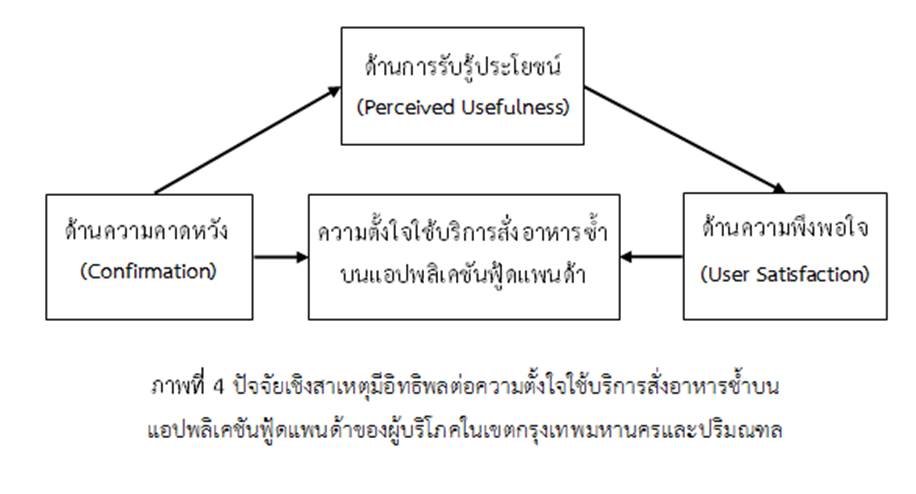CAUSAL FACTORS AFFECTING REPURCHASE INTENTION FOODS ON FOODPANDA APPLICATION OF CONSUMERS IN BANGKOK AND ITS VICINITY
Main Article Content
Abstract
The objectives of this research article were to 1) develop and validate the consistency of a causal relationship model of repurchase intention foods on the Foodpanda application and 2) to study causal factors affecting repurchase intention foods on the Foodpanda application of consumers in Bangkok and its vicinity. The tools used in the research were online questionnaires. The sample group consisted of 375 people who had repurchase intention foods on the Foodpanda application and lived in Bangkok and its vicinity. The statistics used in data analysis where frequency, percentage, and the structural equation model.
The results of the research showed that; 1. the causal relationship model of variables consisting of 4 components were 1) confirmation 2) perceived usefulness 3) satisfaction and 4) repurchase intention and the model was developed in accordance with empirical data. The statistics showed the Chi-square statistics goodness fit test (χ2)=264.41, degrees of freedom(df)=138, CMIN/df=1.79, GFI=0.94, AGFI=0.90, SRMR=0.05, RMSEA=0.05. The final result was a predictive coefficient of 0.89, indicating that the variables in the model can explain repurchase intention foods on Foodpanda application by 89 percent. 2. Causal factors were confirmation, perceived usefulness, satisfaction influences repurchase intention foods on Foodpanda application respectively.
Article Details

This work is licensed under a Creative Commons Attribution-NonCommercial-NoDerivatives 4.0 International License.
References
กรวินท์ ชูพันธ์. (2560). ปัจจัยที่มีผลต่อการตัดสินใจกลับมาใช้บริการซ้ำของผู้ใช้บริการเทรนเนอร์ออนไลน์: กรณีศึกษาเฟซบุ๊ก. วารสารระบบสารสนเทศทางธุรกิจ. 4(2). 40-54.
กริช แรงสูงเนิน. (2554). การวิเคราะห์ปัจจัยด้วย SPSS และ AMOS เพื่อการวิจัย. กรุงเทพมหานคร : ซีเอ็ดยูเคชั่น.
ณรงค์ยศ มหิทธิวาณิชชา. (2562). สถิติและพฤติกรรมการใช้ social media ทั่วโลก Q1 ปี 2020. สืบค้นเมื่อ 14 กุมภาพันธ์ 2565. จาก https://www.twfdigital.com/blog/2019/08/ global-social-media-usage-stats-q3-2019/
บุญมี ยอมพันธ์ และรุจิภาส โพธิ์ทองแสงอรุณ. (2562). บุพปัจจัยที่มีอิทธิพลต่อการตั้งใจเลือกใช้บริการซ้ำของผู้ใช้บริการโรงพยาบาลที่จดทะเบียนกับตลาดหลักทรัพย์ในเขตกรุงเทพมหานคร. วารสารวิชาการ สถาบันเทคโนโลยีแห่งสุวรรณภูมิ. 5(2). 184-196.
รุจิภาส โพธิ์ทองแสงอรุณ. (2563). การวิเคราะห์ความสัมพันธ์เชิงสาเหตุที่มีอิทธิพลต่อการตั้งใจใช้บริการซ้ำในโรงพยาบาลเอกชนที่จดทะเบียนในตลาดหลักทรัพย์และโรงพยาบาลที่ก่อตั้งจากมูลนิธิองค์กรการกุศลในกรุงเทพมหานคร. วารสารนวัตกรรมธุรกิจ การจัดการ และสังคมศาสตร์. 1(1). 1-15.
วุฒิเมศร์ ฉัตรอิสราวิชญ์. (2564). เบื้องหลังของ foodpanda แพลตฟอร์มเดลิเวอรี่อาหารที่มอบประสบการณ์ให้ลูกค้าแบบเรียลไทม์ ผ่านการให้ความสำคัญกับ Data. สืบค้นเมื่อ 14 กุมภาพันธ์ 2565. จาก https://readthecloud.co/foodpanda/
ศิริลักษณ์ หาพันธ์นา.(2563). ก้าวต่อไปของ Foodpanda ขอเป็น “ฟู้ดเดลิเวอรี่ ภูธร”มุ่งเข้าหา “ร้านอาหารเล็ก” ในชุมชน. สืบค้นเมื่อ 14 กุมภาพันธ์ 2565. จากhttps://positioning mag.com/1305563
สำนักงานพัฒนาธุรกิจอิเล็กทรอนิกส์.(2564). ETDA เผยโควิด-19 เป็นเหตุสังเกตได้ Gen Z ใช้เน็ตสูงสุด ปีแรก ชนะ Gen Y แชมป์ 6 สมัย. สืบค้นเมื่อ 14 กุมภาพันธ์ 2565. จากhttps://www.etda.or.th/th/pr-news/ETDA-released-IUB-2021.aspx
สำนักงานสถิติแห่งชาติ. (2563). แนวโน้มคนไทยใช้สมาร์ทโฟนมากขึ้น. สืบค้นเมื่อ 14 กุมภาพันธ์ 2565. จาก http://www.nso.go.th/sites/2014/Pages/ActivityNSO/A24-05-60.aspx
สุมามาลย์ ปานคํา และณัฐยุพา ทิวากรโกมล. (2564). ปัจจัยเชิงสาเหตุที่มีผลต่อความตั้งใจซื้อซ้ำตั๋วเครื่องบินผ่านเว็บไซต์สายการบินนกแอร์ของผู้บริโภคในเขตกรุงเทพมหานครและปริมณฑล.วารสารสหวิทยาการมนุษยศาสตร์และสังคมศาสตร์. 4(2). 41-53.
Hair, J.F., Black, W.C., Babin, B.J., & Anderson, R.E. (2010). Multivariate data analysis. 7th ed. New York : Pearson.
Hoelter, J. W. (1983). The Analysis of Covariance Structures: Goodness-of-Fit Indices. Sociological Methods and Research. 11(3). 325–344.
Hozhabri, A., et al. (2014). Online Re-Purchase Intention: Testing Expectation Confirmation Model ECM on Online Shopping Context in Iran. 8th International Conference on e-Commerce with focus on E-Trust. 24-25 April 2014, Mashhad, Iran.
Kline, R.B. (2011). Principles and Practice of Structural Equation Modeling. 3rd ed. New York, NY : The Guildford Press.


